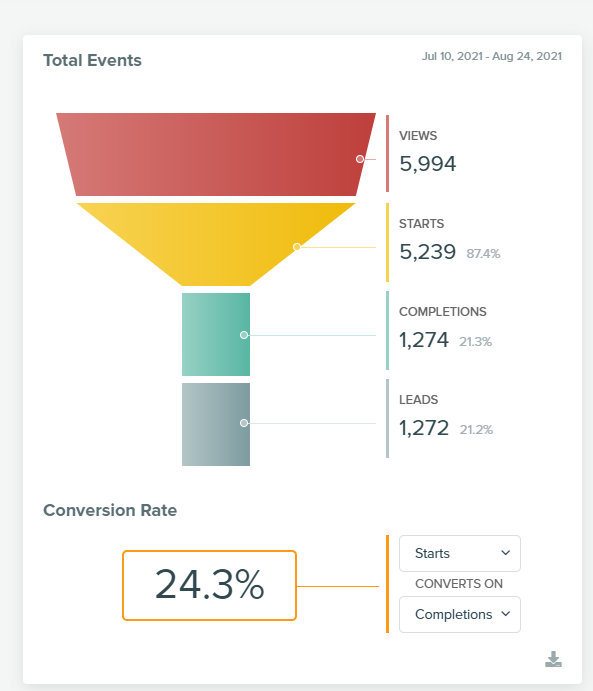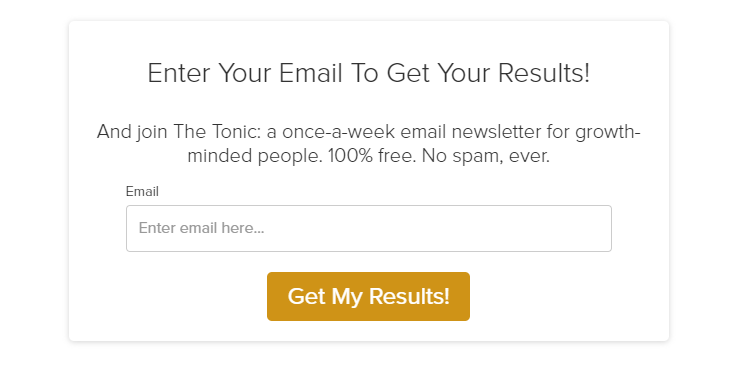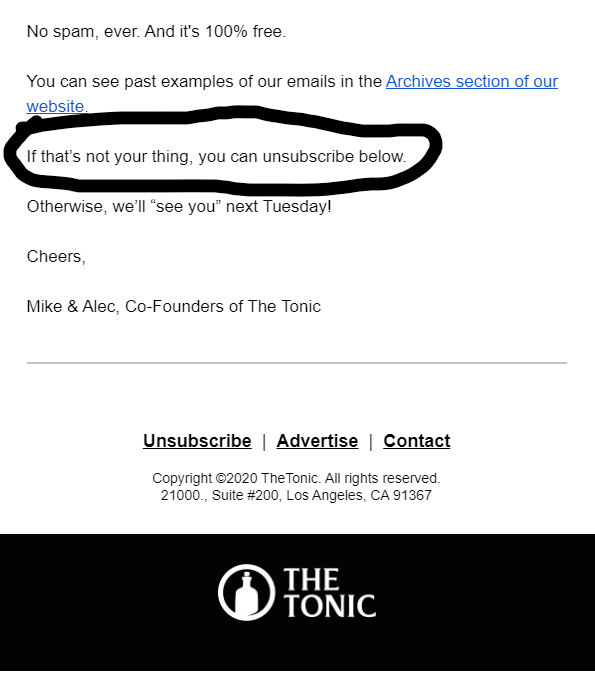My business partner and I launched our free email newsletter in February of 2021 — the intention is to build a big, engaged list and then sell sponsorships.
(We’re also considering selling courses and eBooks down the road)
It’s called The Tonic and it’s for people who care about their personal and professional growth. We deliver curated content, expert insights, and weekly challenges.
Here’s our most recent email as an example…
We send one email every week (on Tuesday at 10 am) that looks something like what you see above.
And for the first six months of 2021, we’ve sent those emails to just over 100 people (almost entirely friends and family) — to start, we privately messaged many of our online connections and asked them to join.
But obviously, that wasn’t going to take us very far.
So after we felt that we’d found our footing in terms of content, tone, and style, we started looking for ways to grow the newsletter.
And the most effective strategy we’ve used (by far) is a quiz.
In fact, the quiz we’re using is currently getting us subscribers at $0.40 a pop (about $0.60 after unsubscribes), and our average open rate is right around 40% — the newsletter that went out today has a 58% open rate so far.
And you could use the same strategy we’re going to describe to generate leads organically if you have the traffic (by creating an exit-intent popup, for instance).
Let’s start by taking a look at the quiz we’re using…
Our Lead-Gen Quiz
Here’s the Facebook ad we’re currently running…

Our targeting for this quiz is pretty darn simple — we’re targeting people in English-speaking countries who are 25+ and are interested in history (our targeting on Twitter is quite similar and the cost per click is slightly higher at $0.12 per click)…

After $200 in ad spend, we were (and still are) getting $0.06 per click (not too shabby!)…

And if we go look at our quiz stats (we built our quiz using TryInteract — highly recommended), we see the conversion rate from start to finish is about 25%…

…which isn’t too bad considering that this is the final page of the quiz (most people probably abandon because they don’t want to enter their email)…

Once people enter their email to get their results, they are sent a results email and our welcome email.
The unsubscribe rate on the welcome email sent to quiz opt-ins is a little high at 6.7% (which equals 70 people)… but that’s to be expected considering the opt-in tactic we’re using.

In fact, we encourage people to unsubscribe in the results email if they don’t think they’ll be interested in our content — this will (hopefully) help preserve the integrity of our engagement metrics (it’s working so far!).

To create the quiz, we researched historical figures and their alleged Myers & Briggs scores according to experts and historians. Then we created a simplified 12-question version of the Myers & Briggs test, aligned the results with the correct historical figures (integrating TryInteract with Klaviyo), and sent people historical figures results rather than Myers & Briggs four-letter scores.
Here, for example, is what one of the results emails looks like…

Our Primary Concern
When we decided to create a quiz to grow our email list, it was an experiment — we really weren’t sure how well it would work.
We chose to create a quiz about historical figures because we figure that people who are interested in history are also probably interested in the type of content we send out at The Tonic — scientific anecdotes, expert insights, and personal growth advice.
That overlap isn’t perfect, but it’s proven to be at least somewhat accurate.
Our primary concern with the quiz was that we’d get subscribers, but engagement would plummet and both usubscribes and spam complaints would skyrocket.
That isn’t what has happened.
The email we sent out this morning (and it’s still sending) already has a 57% open rate (that’s 554 people) and only 9 unsubscribes.
The last three emails we sent had a 31%, 53%, and 27% open rate.

Those are surprisingly respectable metrics.
And we think there are a few reasons that this personality quiz tactic is working for us to generate high-quality subscribers.
First, our biggest focus is on the quality of our content. While The Tonic might not be as niche as some entrepreneurs think it should be, it is interesting — we’ve talked about fasting, depression, anxiety, salary negotiations, testosterone, peanut allergy, fatherhood, dark matter, copywriting, vending machines, and tons of other topics.
Humans are curious.
And we think The Tonic leverages human curiosity to keep people engaged — no matter who they are or where they come from.
Additionally, The Tonic doesn’t require any sort of reciprocation from the subscribers. It’s there purely for their benefit and enjoyment.
So it’s probably not something that people are in a hurry to get rid of.
Maybe they didn’t like this week’s email… but maybe they’ll like next week’s email — and there’s no risk to wait and find out.
(This is the benefit of free email newsletters)
Conversely, if we used this quiz to generate leads and then started bombarding people with sales emails and pitches (or even with low-quality email newsletters), we would expect our metrics to be in a lot worse shape.
All in all, we’re paying about $0.60 per subscriber after accounting for unsubscribes and over the last two weeks, we’ve paid about $400 to get past the 1,000 subscriber milestone.
And since the quiz and its ads are still working — and since quality seems to hold up — we’re going to take this lead-gen source as far as we can take it.
The next goal is 10,000.
We’ll let you know once we get there!

